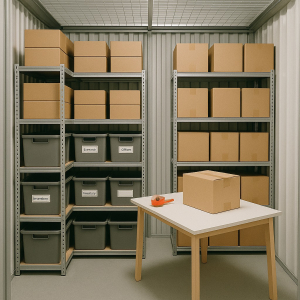How to Use a Storage Unit as an E-Commerce Warehouse
Ecommerce Storage Solutions That Work
Running an online business is exciting—but let’s be honest, stock takes up space. Whether you’re selling handmade crafts, vintage clothes, or imported tech accessories, most e-commerce businesses hit the same problem early on:
Where do I keep everything?
That’s why more entrepreneurs are turning to creative, low-cost ecommerce storage solutions to manage their growing inventory—without committing to a full warehouse lease.
The Reality of Running an Online Business from Home
For many small business owners, the first warehouse is a spare bedroom or the kitchen table. But as orders grow and packaging materials multiply, things start to feel cramped quickly. At some point, you need a dedicated space to store products, pack orders, and maybe even take product photos—without tripping over bubble wrap in the hallway.

Why Storage Units Work for E-Commerce
While traditional warehouses are expensive and often oversized for small sellers, a storage unit offers a simple, cost-effective middle ground. Many e-commerce businesses use them to:
-
Store inventory in an organised, secure space
-
Set up a packing and shipping station
-
Separate personal life from business clutter
-
Scale up as needed without long-term leases
This makes them an ideal warehouse alternative—especially for solo founders or small teams.

How to Set One Up
Turning a standard unit into a functional work zone doesn’t require much. Here’s what many e-commerce sellers include:
-
Shelving units for vertical storage and easy access to stock
-
Labelled boxes or bins sorted by SKU, size, or product category
-
A foldable table for packing and preparing orders
-
Lighting and power (if allowed), especially for working during darker hours
-
Basic tools like a scale, tape dispenser, and shipping labels
Some sellers even keep marketing materials or photography gear on-site, creating a mini fulfilment centre that fits their scale and budget.

Tips for Staying Organised
A little planning goes a long way when working from a storage unit. Here are a few quick tips:
-
Use clear bins or windows so you can see stock at a glance
-
Keep a digital inventory list synced with your shop
-
Place high-turnover items at the front for faster access
-
Schedule regular stock checks to stay ahead of low inventory
-
Bundle packaging supplies together to avoid digging through boxes
By treating the unit like an extension of your shop—not just a dumping ground—you’ll save time, stay efficient, and reduce packing mistakes.
The Flexibility Factor
Unlike long warehouse contracts, most storage units offer flexible rental terms. That means you can increase or reduce your space as needed—a huge bonus during seasonal spikes or business transitions.
This flexibility is one of the reasons these units are becoming a go-to choice for people searching for smart small business storage options.

Final Thoughts
As more people run businesses from home, it’s no surprise that practical, affordable ecommerce storage solutions are in demand. Whether you’re just starting out or growing quickly, using a storage unit as your mini warehouse could give you the space (and sanity) you need to keep moving forward.

